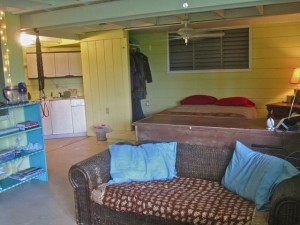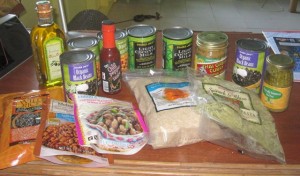While Chris and I don’t stress about trying to follow a budget (our life is too variable!), a data geek like me enjoys tracking expenses and analyzing trends. We have a cost log published going back a couple years, and we know that many people have found it valuable to get a real-world example of what it costs to live a nomadic life.
Before going nomadic, we each had more typical households with all their expenses. After nearly 4 years on the road, habits and priorities change. We got out of the consumer spending cycle, not just to save money – but because we had no space to store stuff when living in 80 square feet.
We’ve continued tracking our expenses as we’ve transitioned to a temporarily more stationary lifestyle here in St. John, and one of the intriguing aspects of parking our RV and moving here has been seeing how our spending habits have not changed much while being stationary.
Housing Costs
While traveling in our RV, I considered our campground fees plus our fuel to be the equivalent of a rent or a mortgage payment. Especially since we paid for our trailer and tow vehicle in cash, and thus we had no monthly payments to worry about.
-

Our St. John Efficiency Digs For our 10 RV’ing months in 2010, we averaged $694/month for camping (which generally included all utilities, plus propane) and fuel costs. While we’re in St. John, we’re blessed to have a friend who offered to let us park it on their property so we don’t have storage fees.
- The rent on our little St. John efficiency is $700/month, which includes cistern water (not drinking water) and electricity. We have to provide our own propane for the stove, which is $118 for a 100 lb tank, which should hopefully last us our entire stay. Similar short-term rentals here cost a lot more, but we scored a great deal by subletting from a friend who plans to move here permanently, and who had locked in a long-term lease.
We consider our housing costs to be a wash when comparing these two different forms of nomadic housing. It’s part of what really attracted us to this specific opportunity – for the same cost, we could winter in tropical paradise? Score!
Connectivity
While in the RV, we had service for our two iPhones, our iPad, our Sprint data card (through Millencom: side note, they’ve recently changed their Sprint plan back to unlimited, and their Verizon to 20GB/month, great deals!) and our Hughesnet Satellite dish. The net cost was a bit over $300/month. Ouch! But – connectivity is what makes our digitally nomadic lifestyle possible.
On island, we ended up going with Choice’s WiMax 4G service at our home, for a cost of $55/month with no contract. Since we weren’t able to get decent data service on Sprint anywhere on island, we canceled our no-contract Millencom account, and we also suspended our no-contract Hughesnet account – saving us $140/month.
As our back-up and around-island connectivity, we enabled tethering through AT&T on one of our iPhones, increasing our monthly costs by $15 (we previously had an unlimited data plan). AT&T may have a relatively lacking network across much of the country, but they have the best service in the US Virgin Islands. For once, we’re glad we’re tied to AT&T!
All sorted out, we’re realizing about a $70/month connectivity savings.
Food
Normally, I don’t report our food expenses on our public cost log – they’re so variable and personalized, that I just don’t feel that our costs will be useful to others. However, the cost of food is one of the major cost of living differences, so I found it interesting to see how our food bill changed.
On St. John, groceries cost roughly 1.5x – 3x the as stateside prices. This markup comes from a combination of everything having to be shipped in (usually via Miami), lack of economies of scale, and it being high tourist season on a destination resort island. We noticed prices in Cruz Bay creeping higher as tourist season peaked.
The cheapest grocery option is to take the car ferry over to St. Thomas and stock up at a warehouse store. However, since it’s an all day affair and costs $48 roundtrip to take the car ferry, you have to do a lot of stocking up to make it worthwhile.
Here’s some examples of grocery prices on St. John:
- 1 lb of tofu – $3.95
- Morningstar Farms products – $6.99
-

This red onion cost $4.77! Can of black beans – $1.95
- Can of Ro-tel tomatoes – $2.29
- 10 large flour tortillas – $3.29
- Bag of tortilla chips – $7.99 (Chris is in agony over this…)
- Small jar of salsa – $4.69
- Box of cereal – $6.99
- 1/2 gallon of ice cream – $8.99
- 8 lbs Purina cat chow – $8.99
- 14 lbs clumping cat litter – $9.65
- 1/2 gallon of milk – $4.59
- 1 lb block of cheddar cheese – $7.99
- 1 gallon of Tropicana OJ – $11.95
- 5 lbs red potatoes – $7.09
- Bananas – $.99/lb
- Zucchini – $2.49/lb
- Head of iceberg lettuce – $3.09
- Red onion – $2.49/lb
- Roma tomatoes – $2.29/lb
- Box of frozen perogies – $5.49
- Box of 9 Bagel Bites – $4.89
- 4 double rolls of toilet paper – $5.59
- 1.75 Liters of Rum – $8.49
No matter how much folks warned us about food costs in advance, and even sent us grocery ads, we spent the first couple of weeks here in sticker shock. The only good deal was the rum. As a result, drinks are mixed strong here because the liquor costs less than the mixers!

By now, we’re acclimated to the prices, have cut back on the rum, stocked up when things are on sale, and we’ve been buying frozen bulk vegetables and made a stock-up run to St. Thomas for non-perishable items. Family and friends have also been sending us care packages of things we can’t find here – like treats from Trader Joe’s, pad thai sauce (we can find pad thai noodles) and other favorites.
In talking to a lot of St. Johnians – it seems folks lose weight after moving here (we’ve each dropped about 5-10 lbs ourselves) between lots of hiking and snorkeling, and the cost of food. Notice how junk and processed food tends to be much more expensive than stateside prices, and veggies are typically only a smaller mark-up?
Yeah, it’s probably a good thing overall. The St. John diet plan.
Eating out here is mighty expensive too. At most places, you’re looking at spending $10-15 on a fish sandwich or burger, or $18-32 for an entree style meal. However, your meals often comes along with awesome live music entertainment in the evenings and are freshly prepared by expert chefs. The other plus, there isn’t a single big chain restaurant or store on island, everything is locally owned. The expert chef? Probably your neighbor, or the dude you picked up hitchhiking yesterday. We love that.
We have found a few places that realize that locals don’t have vacation budgets:
- Donkey Diner for pizza & breakfast (we can split a huge pie and donkey balls, or a very filling brunch for under $20 total.)
- Lone Star Taqueria (offering small tacos for $2.50/each.)
- Deli Grotto (we can each get a scrumptious sandwich on fresh baked bread for about $15 total.)
- Tourist Trap (reminiscent of a Burning Man theme camp on the way back from some of our favorite beaches, they serve yummy grouper tacos for $7.)
For our 2010 RVing travels, we averaged about $650/month for food. And that was roughly split between dining out and groceries.
On St. John, our food bill has been $750/month. Which isn’t that huge of an overall increase. However, less than 20% of that is towards dining out. We’re eating in a lot more – which is not only helping contain food costs, but is obviously better for our health. And I’m enjoying cooking in a real kitchen again.
Up Front Costs
While overall our monthly cost of living is about the same as living in the RV, we would be negligent if we didn’t mention that we had some substantial upfront costs getting our life temporarily relocated here – including the travel costs to get here, deposit on the place, buying an old Jeep (that we’ll sell before we leave for hopefully near what we paid), Wimax modem & installation and we had to purchase some household goods for our only partly furnished efficiency (like, a blender for all that rum!).
Of course, our RVing lifestyle also had upfront costs to get started.
Should we do other extended rental stays in places as we travel (which we’re definitely keeping as a future option – we’re totally digging this relaxed immersive pace of travel), we’ll definitely be looking for better furnished places to save the hassle and expense of having to setup a homebase so much.


Folks, feel free to come and stay at my casa in Independence, CA. this winter. I’ve power, water, maybe sewer for you, plus a great place to park.
Yours freely, AK
The island with its tropical climate seems like the perfect place for a motorcycle, especially a dual sport type with off road capability. Do you see many there? And if you had your own already, along for RV travels for example, would it seem prudent to take over with you from the mainly or is that cost prohibitive?
There are a few motorcycles we see here.. but not many. Mostly Jeeps and Suzukis on island.
I’m not the best resource for asking about motorcycles, as I’m pretty much scared to death of them (witnessed too many fatal accidents involving them growing up) and wouldn’t ever consider owning one. 🙂
I have no clue what it costs to ship big things over here… but the folks who live here full time seem to regularly ship their vehicles over. So would imagine there must be a cost advantage to it. For us, for the short amount of time we’re here – it would have been cost and logistically silly to do.
Great article guys!
I’m trying to make the leap to the nomadic lifestyle but don’t want invest in an RV yet. Have you crossed paths with any nomads who use short term renting or subleasing as a housing option?
Oh yes, indeed.. it’s a very common form of nomadism. A lot of global nomads do short term leasing/subletting as a way to manage housing when they’re moving at a slower pace than would be affordable or comfortable for hostels and couchsurfing.
Another way folks handle it is house swapping and/or house/pet sitting.
Great information yet again! Thank you very much for sharing the costs!
Our pleasure.. we hope that sharing helps others!